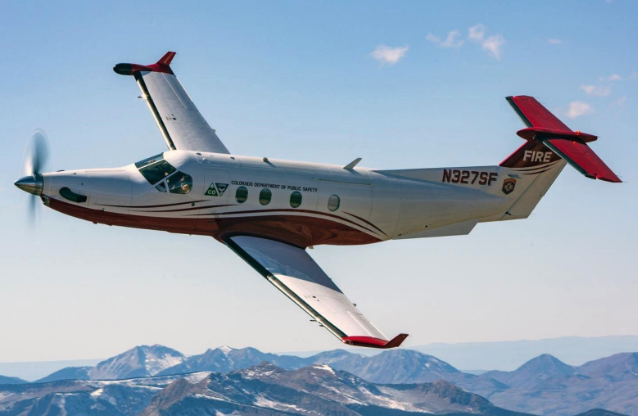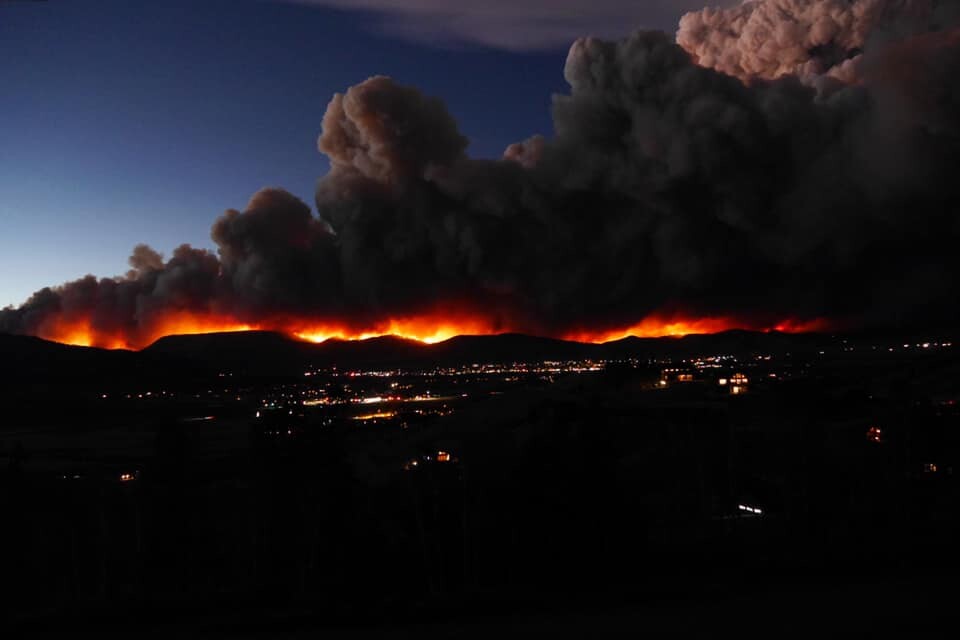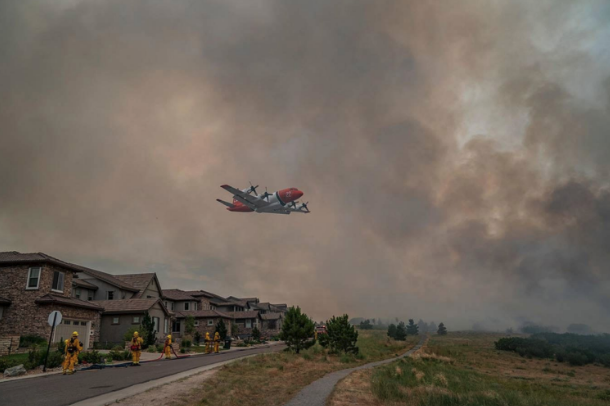DENVER — On a day of “extremely critical” fire weather across the entire eastern half of Colorado, state officials provided an annual wildfire forecast on Friday, detailing what they expect from this year’s wildfires and how residents across the state can stay safe.
Mike Morgan, director of the Colorado Division of Fire Prevention and Control (DFPC), said the state is more prepared than ever before to attack wildfires this year, however he stressed the importance of public awareness surrounding activities that can ignite a fire — anything from agricultural burning to barbecuing to dragging trailer chains on the road.
“I feel good about how prepared we are, but I know we’re going to have some tough days, some bad days,” he said.
The presentation and release of the state’s 2022 Wildfire Preparedness Plan came in the wake of a multitude of wildfires this week, including the Monte Vista Fire, which displaced six families on Thursday, the Table Mountain Fire near Longmont, and the Duck Pond Fire near Gypsum, among several others. A handful of fires broke out Friday as well.
Morgan explained that as 2022 progresses, drought conditions and the high likelihood of large fires will travel across the southern half of the state to the western slope. By late June, the western slope may see monsoonal moisture, Morgan said. Along the Front Range, current forecasts show that extreme drought conditions will continue into July.
Projections suggest an earlier-than-normal start to the “core fire season” in the second half of May across southern Colorado, according to the Wildfire Preparedness Plan. Warm and dry conditions will bring “drought intensification” and early snowpack runoff, the plan reads.
"While it is too early to forecast with accuracy what the 2022 core fire season will bring for certain, significant wildland fire potential is expected to remain above normal in many areas of Colorado during the late spring and into summer," the report reads.

Click here to read the 32-page Wildfire Preparedness Plan in full.
Morgan said firefighters’ strategy for future wildfires is simple: detect them early and attack aggressively.
One important aspect of that plan is the state’s multi-mission aircraft, which uses infrared and color sensors to find fires. Since 2015, it has helped fire officials detect more than 600 fires that “nobody knew about,” Morgan said. Sometimes, a fire chief or sheriff will ask for the plane to fly over an area with a lot of human activity (and possible campfires), he said. In other situations, such as a thunderstorm with a lot of lightning, the multi-mission aircraft will fly over areas that DFPC’s federal partners, like NOAA, say see a lot of strikes.

If a fire is spotted, the longitude and latitude is passed along to the local agency in charge, Morgan said.
The average number of wildfires over the past 10 years was 5,507 per year, but last year alone, 6,709 fires were reported, Morgan said. Most of those were small, and were extinguished before they even had a name.
While plenty of those smaller fires burn across the state each year, many break out that require more than just one agency’s response, said Colorado Department of Public Safety Executive Director Stan Hilkey, adding that collaborative mitigation efforts are critically important.
That’s why one of the No. 1 recommendations from the Colorado Fire Commission is the implementation of a statewide fire resource mobilization dispatch center, where officials can coordinate with all of Colorado’s fire-related resources yearround. The recommendation was approved by the Legislature and development for it is ongoing. It will be called Colorado Coordinated Regional Mutual Aid System, or CCRMAS.
Morgan called this a “huge step forward for us.”
“What this allows us to do is to build a statewide dispatch center in partnership with our federal partners, so we would be working with them to dispatch aviation assets as well as a regional and statewide mutual aid system for fire-based resources,” he said.

In the short term, the program will focus on hiring staff, implementing actions to streamline notifications and developing formal rules.
In addition, a preparedness level system — something the DFPC’s federal partners have utilized for years — will help the state prepare resources by sending them to different parts of the state based on predicted fire behavior.
Hilkey stressed that most wildland fires are either caused by, or involve, humans, and they need to take responsibility for their actions when fire danger exists. That means understanding various fire bans and restrictions.
In addition, residents are encouraged to opt-in to county alerts so they can learn if there is a threat — wildfire or otherwise — in their area. To sign up for county-level alerts for emergencies, click here.
On the state side, officials are prepared to have a fleet of various aircraft to help fight wildfires.
Hilkey said new legislation, which was announced earlier Friday, would provide $15 million for the Disaster Resilience Rebuilding Program, which would add to the state’s aviation resources already on contract. The funds would pay for the extension of Colorado’s contract of a large airtanker and a second large airtanker, as well as two Type 1 helicopters, Hilkey said. He acknowledged that Colorado will compete with other states for the contract.

In total, this would bring the state’s fleet to three Type 1 helicopters, two Type 2 helicopters, two large airtankers, two multi-mission aircraft, and two single-engine air tankers.
In addition to these aircraft, Colorado has a Firehawk coming later this year, though it will only become available in November or December. The DFPC is expected to take control of the aircraft, a Sikorsky S70i Firehawk helicopter, which is a state-of-the-art helicopter fully equipped to help with firefighting efforts across the state, after it arrives in the state in May. It will then be converted into a FireHawk by the end of the year.
The $24-million helicopter is outfitted with a 1,000-gallon water tank, extended landing gear to accommodate the tank, a retractable snorkel that can refill the tank in less than one minute, and a rescue hoist. In addition to attacking wildfires, the state-owned aircraft can transport up to 12 firefighters to the fire line and rescue people when needed. It is designed to stop fires before they can grow.

Ahead of the presentation, Gov. Jared Polis and Colorado officials announced new legislation to aid in wildfire preparedness, response and recovery. It would create two different grant fund programs — the $15 million for the Disaster Resilience Rebuilding Program and $20 million for the Sustainable Rebuilding Program — that will help homeowners, businesses and governmental entities in the rebuilding process after a natural disaster.
Senate Bill 206 also creates the Office of Climate Preparedness that will help prepare for wildfire response in the future.
Officials also announced an additional nearly $20 million in funds from leftover FEMA funding from 2020 fires for equipment and technology needed to respond in the 2022 fire season.
In-depth on current snowpack, drought in Colorado
Colorado’s snowpack has already started its decline after peaking over the past couple of weeks. The median peak (16.8 inches of snow-water equivalent) over the 1991-2020 period was April 8, and Colorado’s snowpack sat around 14 inches of snow-water equivalent at the end of March and first two weeks of April.
This week, the snowpack fell below 13 inches of snow-water equivalent and below 90% of median levels for the 30-year period. It could be buoyed slightly by a storm this weekend but is expected to continue to melt as we head toward summer.
The statewide snowpack is now close to the trajectory it followed in 2021. In 2020, the snowpack was slightly more robust at this time of the year. In 2019, the snowpack was well above median levels for this time of year, and it stuck around much longer because of several strong spring snowstorms.
The snowpack in 2018 was among the worst on record for the past 30 years and maxed out at around 11.5 inches of snow-water equivalent in April before a summer filled with wildfires.
Five of the state’s eight river basins were still above 90% of median levels this week – the Gunnison, Upper Colorado Headwaters, South Platte, Laramie and North Platte, and Yampa and White basins.
Meanwhile, the Arkansas, Upper Rio Grande, and San Miguel, Dolores, Animas and San Juan basins all fell below 80% of median levels this week.
That is due in part to the northern half of the state seeing near- or above-normal precipitation levels for the first part of April and the southern half of the state seeing about half of what it normally sees through the first three weeks of the month.
A quick melt-off of the snowpack, and lack of precipitation in the spring and early summer, would create worsening drought conditions and drier fuels that would be conducive to more fire starts and fires that could burn faster once they spark.
Peter Goble, a research associate at Colorado State University who works at the Colorado Climate Center there, said while this year’s snowpack is slightly better than it was last year, it won’t be enough to fill up some of Colorado’s western reservoirs or help the water crisis in the Colorado River Basin.
Don Meyer, the senior water resource engineer for the Colorado River Water Conservation District, shared similar sentiments, saying he believes most of the Western Slope reservoirs will not fill up this year and that continuing drought across the West could continue to stretch water resources.
Ben Livneh, an assistant professor at the University of Colorado’s Department of Civil Engineering, said Colorado and other parts of the West would need several years of strong precipitation to break out of the drought.
“We should count our blessings that we have the snow that we do this year,” Livneh said. “We sort of need a few more years like this one and even bigger years to start kind of digging out of the long drought that we’re in.”
Colorado is currently in a similar, albeit slightly better, position drought-wise to where it was at this point last year.
All of the state is abnormally dry, and 87% of the state is experiencing moderate or worse drought. Thirty-three percent of the state is experiencing severe drought or worse conditions. And 4% of the state is experiencing extreme or exceptional drought conditions.
This week a year ago, 32% of the state was seeing extreme or exceptional drought, and 15% of Colorado was seeing exceptional drought – mostly on the Western Slope.
This dryness has had a profound impact on the Colorado River, which starts in Colorado and winds downstream to several other western states. The river was named the most endangered river in the United States by the nonprofit American Rivers on Tuesday. The report detailed how the ongoing drought has been shrinking snowpack amid hotter temperatures, which is evident when looking at the dry, white rings of rock above the waterline at Lake Powell and Lake Mead — two reservoirs off the Colorado River that have seen extremely low levels recently.
A look at recent years’ forecasts, wildfires
The Colorado wildfires in 2020 were record-breaking in size. The Hayman Fire, which burned about 137,000 acres in 2002, had stood as the largest wildfire in the state for the previous 18 years, but was bumped down to No. 4 following the 2020 season, behind the 208,913-acre Cameron Peak Fire, 193,812-acre East Troublesome Fire, and 139,007-acre Pine Gulch Fire.
In October, both the Cameron Peak Fire and East Troublesome Fire made multi-mile runs overnight, forcing massive evacuations. They torched a collective 1,000 structures.
READ MORE: The untold stories of resilience and recovery in Grand Lake after the East Troublesome Fire
In April 2021, the Colorado Division of Fire Prevention and Control released its annual forecast for wildfires, and explained how Coloradans should expect another year of intense fires due to ongoing drought conditions, much like what the state saw in 2020.
The 2021 forecast read that the earlier-than-average snowpack runoff — much like what is outlined in the 2022 forecast — was likely to lead to “above normal large fire potential expanding northward through the month of June and affecting the majority of the western slope by July.”
However, due to higher-than-average precipitation and slow-moving storms in the late spring and early summer in 2021, mudslides and debris slides in 2020 fire burn scars became an arguably larger concern throughout the summer.
One of the most problematic areas was Interstate 70 through Glenwood Canyon, which had to close on and off throughout the summer due to slides that covered the highway. In just three days — July 26 to July 28 — I-70 closed 12 times. On July 29, the interstate was closed for about two weeks due to flash flooding and multiple large mudslides, and Gov. Jared Polis issued two disaster declarations. The highway had “extensive damage,” according to CDOT.
Flash flooding hit the Cameron Peak Fire burn scar in July 2021, causing a mudslide that ran through Poudre Canyon and subsequent evacuations, and left four people dead.
Several other burn scars around the state saw similar slides, including the scar from the East Troublesome Fire in Grand County.
Around the first day of summer, the largest wildfire of the year broke out in Rio Blanco County: the Oil Springs Fire. However, when compared to the largest fires of 2020 — the Cameron Peak Fire, East Troublesome Fire, and Pine Gulch Fire — the Oil Springs Fire was relatively small at about 12,000 acres.
A few other wildfires broke out in the following months, including the 4,000-acre Muddy Slide Fire and 7,500-acre Morgan Creek Fire, both in Routt County.
The various fires from in state but mostly out of state also resulted in poor air quality around the Denver metro area. On Aug. 6, Denver was ranked the worst city in the world for air quality, according to a real-time air quality information platform on IQAir's website.
Earlier this month, the U.S. Environmental Protection Agency announced it was proposing downgrading the northern Front Range ozone issues from “serious” to “severe” — a change that would require officials to cut emissions and pollution in the Denver metro region. Combined with wildfire smoke from both inside Colorado and out of state, the ozone and particulate levels have created extremely poor air quality in the metro area several times over the past few years.





